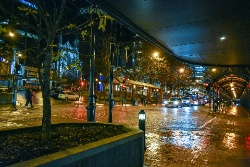Humpback whale washed up on Waikanae Beach
29 October 2014
Humpback whale washed up on Waikanae Beach
A 10 metre whale has washed up on Waikanae Beach, south of Waikanae Boat Club.
DOC is working with local iwi Te Atiawa ki Whakarongotai to ensure tikanga is followed in management of the whale on the beach, and during the burial process.
Brent Tandy, DOC Senior Ranger, confirmed it is a humpback whale, “It is approximately 10 meters long, and estimated at 20-30 tonnes.”
“The cause of death is unknown, but it is possible we can identify which whale this is from markings on the fluke. We would do this using a national database of DOC sightings of humpback whales. The smaller size of the whale suggests it is not fully mature,” said Mr Tandy.
The whale appears to have been dead for some time, and public are being advised to keep a safe distance from the whale for health reasons.
DOC Partnership Manager Paul McArthur said “It is sad when a whale dies, but it does provide people with an opportunity to learn more about these magnificent creatures. We just ask that people work with us to respect the body of the whale, and to ensure the safety of people on the beach.”
Due to tide and weather conditions, DOC and Te Atiawa ki Whakarongotai are planning to bury the whale at a site on the Kapiti Coast early tomorrow morning.
Background
information
Humpback whales are frequently visit
New Zealand coasts when they migrate between feeding grounds
in Antarctica, and winter calving and breeding grounds in
warmer waters. They travel mainly along the east-coast and
Cook Strait during winter, and return along the west-coast
during spring.
Humpbacks are baleen feeders with a generalised diet, including krill and small schooling fish (e.g. mackerel and herring). They show the most diverse feeding techniques of all baleen whales, including lunging through patches of prey, stunning prey with their flippers, and forming "bubble-nets".
In the Southern hemisphere, commercial whaling in the 1900s brought humpbacks close to extinction. Most populations now appear to be recovering, but they are still known to die from entanglement in fishing gear and collisions with ships.
The Department of Conservation has been undertaking whale surveys in Cook Strait annually since 2004 to determine the present status and level of recovery of humpback whales in New Zealand waters. It also sheds light on the migratory pathways and destinations of these whales. This information will be used for management of these whales and further their protection in the Southern hemisphere. This is the only project of its kind in New Zealand waters.
For more information see www.doc.govt.nz
Exactly 110 years ago, on 29 October 1904, a 54ft ‘Wright’ whale washed up on Waikane Beach, discovered by Wi Parata. http://paperspast.natlib.govt.nz/cgi-bin/paperspast?a=d&d=WDT19041103.2.22.18
ENDS


 Gordon Campbell: On The Hamas Ceasefire Offer, And Mark Mitchell’s Incompetence
Gordon Campbell: On The Hamas Ceasefire Offer, And Mark Mitchell’s Incompetence Wellington Office of the Mayor: Mayor Responds To Housing Minister’s District Plan Decision
Wellington Office of the Mayor: Mayor Responds To Housing Minister’s District Plan Decision Stats NZ: Have Your Say On Modernising The Census
Stats NZ: Have Your Say On Modernising The Census NZ Government: Therapeutic Products Act To Be Repealed
NZ Government: Therapeutic Products Act To Be Repealed The Treasury: Interim Financial Statements Of The Government For Nine Months Ended 31-3-2024
The Treasury: Interim Financial Statements Of The Government For Nine Months Ended 31-3-2024  Government: New Zealand Sign Language Week An Opportunity For Anyone To Sign
Government: New Zealand Sign Language Week An Opportunity For Anyone To Sign ACT New Zealand: Investment In Prisons Delivers On ACT Commitment
ACT New Zealand: Investment In Prisons Delivers On ACT Commitment


